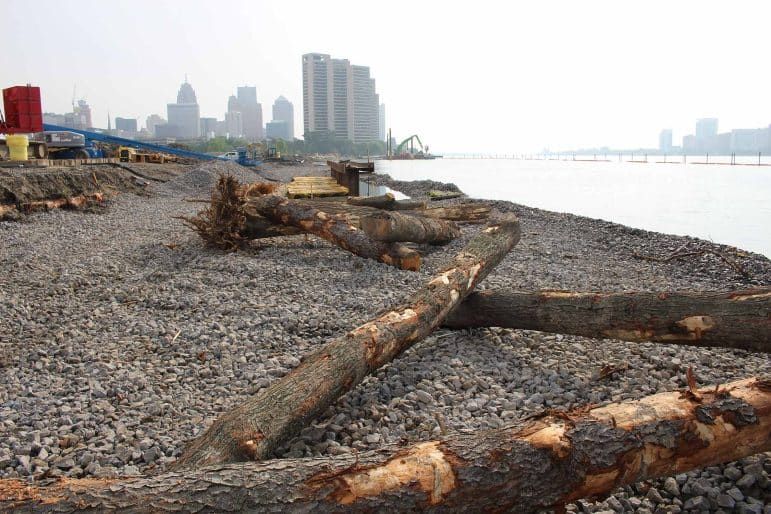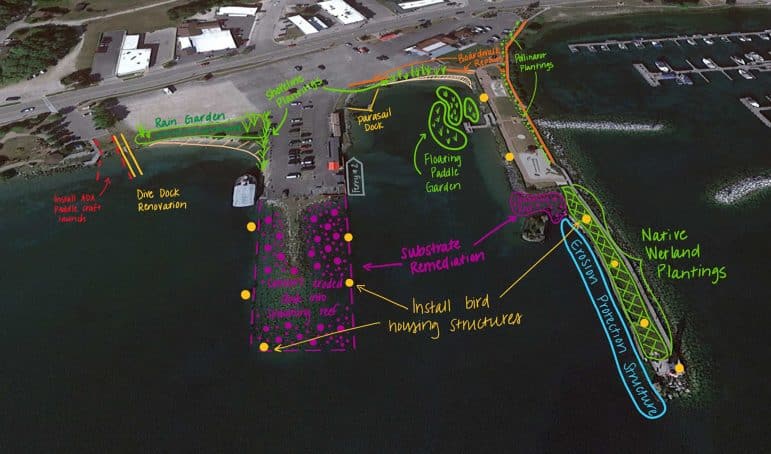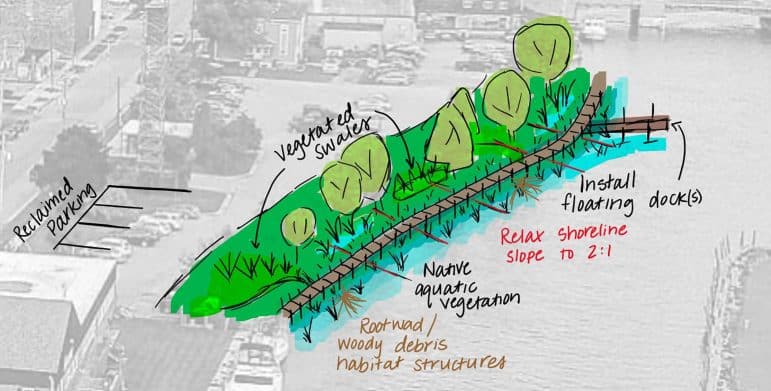
Urban Ecology – Bringing Nature to the Built Environment
If we’re serious about envisioning a world that’s getting back to a healthier relationship with nature, we need to challenge the typical notions of cities: how they’re built, what they’re built out of, and how they manage the complex flows of water, energy, goods, and people.
By Tim Dekker, CEO & President (Ann Arbor, MI), Michelle Platz, Environmental Engineer (Ann Arbor, MI), and Craig Taylor, Hydraulics and River Rehabilitation Specialist (Oakdale, MN)
March 31, 2025
People need nature. We all recognize this truth at a basic level, yet the trends we’re experiencing as residents of an increasingly crowded and resource-demanding world are taking us farther from harmony with nature every day. There’s little doubt that we’re in an urbanizing world: as of 2023, 56% of the world’s population resided in an urban area, and experts project nearly 70% of the population will be urban by 2050 (1). That’s most of us.
Many smart people are working hard to adapt to this new reality, and the results are starting to show. Nature-Based Solutions (NBS) are becoming part of the common language and are progressively seen as the default approach to solving all kinds of challenging problems. The U.S. Army Corps of Engineers (USACE) Engineering with Nature (EWN®) program is taking NBS concepts and is increasingly making them a part of normal operations.
But there’s more work to be done. Our cities haven’t cracked the code on how to truly integrate natural processes into the daily life of a city. We have parks, turf, and street trees, but the hard surfaces and rigid structures that make up most of our urban environments aren’t friendly to natural processes. We have a vision of cities that are greener, cleaner, and just better, but as a society, we struggle with how to get there.
Our cities haven’t cracked the code on how to truly integrate natural processes into the daily life of a city.
If we’re serious about envisioning a world that’s getting back to a healthier relationship with nature, we need to challenge the typical notions of cities: how they’re built, what they’re built out of, and how they manage the complex flows of water, energy, goods, and people. There’s an emerging consensus that if we do this well, we’ll discover ways to manage cities and our lives in them in ways that benefit nature and us. This isn’t a new idea − the sustainability paradigm says that environmental, economic, and social benefits are closely linked. It’s a core belief of our firm. Still, we also know that the triple bottom line is insufficient as a set of guiding principles for improving the way we bring the science of urban ecology to restoration practice.
For that, we need a better definition of urban ecological restoration and guidelines for how we meaningfully incorporate ecological thinking into the infrastructure investments that cities make year by year and over decades. It’s something we think about a lot in our practice, and we’ve had the privilege of contributing to projects that have helped to better define the core ideas of urban ecology and restoration. We’ve also had the great pleasure of discovering other practitioners in related disciplines who share our curiosity about the unfolding practice of urban ecology: landscape architects; ecologists; stream, river, and coastal geomorphologists; and social scientists who help us understand how humans experience nature.

Through these interdisciplinary interactions, we’ve found a few core elements that seem to be common to the most challenging and successful urban restoration projects. Physical, biochemical, and ecological function; structural and process complexity; and connection, both ecological and human, are all basic elements of any successful ecosystem restoration, and they map directly to our work in urban ecosystems.
Function
In even the most “natural” systems, restoration is best thought of as a way to elevate natural functions in settings where these services have been degraded. In urban environments, many of the functions that used to be provided by nature have been taken over by built infrastructure: pipes that manage stormwater, basins that trap sediment, and water treatment plants that take the place of natural biological and physical treatment processes.

While infrastructure provides primary functions, it doesn’t give us the full range of functions observed in nature. Stormwater pipes can convey water from the streets to the rivers, but they don’t provide fish habitat, groundwater recharge, bird nesting grounds, or a thousand other services that streams provide. They just convey water.
The practice of functional restoration acknowledges that recreating some pre-existing ideal isn’t possible and shifts our focus towards restoring nature’s functions within our communities. We may not be able to reproduce all of nature’s complex functionality in our cities, but getting away from monofunctional designs is the right step toward discovering a new, better urban ecology.
Complexity
That takes us to complexity – as we explore the possibilities of urban ecologies, we are naturally drawn into a way of thinking that’s different from the traditional ways of designing hard infrastructure. For hundreds of years, engineering has been about reducing a problem to its essential elements and finding the best solution to the most narrowly defined problem. Designing with nature is different – it’s more exploratory. It allows natural processes to develop their own complex forms, and it’s all about change – natural systems adapt and grow in response to their environments.

Nature’s complexity is its strength. As a wetland evolves, its plants adapt to facilitate growth, and its microbial communities and biogeochemical cycles shift to process new inputs. Similarly, river cross-sections self-adjust to changes in their hydrologic forces. In urban settings, we have to find ways to benefit from the dynamism and adaptivity of natural systems while honoring the things we can’t compromise on – functional roadways, reliable power, and homes that are safe from flooding. When we design our urban infrastructure to support nature’s complexity, natural functions assert themselves to support a new urban ecology that thrives on its own and builds resilience. Our job, then, becomes less about engineering and more about caretaking.
Connection
Allowing nature to step in and take back those functional roles leads to natural systems that work better for interconnected ecologies and feel right for people. We’re all wired to know good habitat when we experience it – how it looks, sounds, and smells. Even the most urban among us inherently know when it’s right. That sense has everything to do with our connection to nature and our expectations about the complexity and interconnectivity of the natural world. When we reconnect our urban environments to water, soil, plants, and wildlife, we also reconnect ourselves to nature and become more deeply connected participants in the natural processes and interactions happening around us.
Allowing nature to step in and take back those functional roles leads to natural systems that work better for interconnected ecologies and feel right for people.
So, what’s the better definition of urban ecological restoration? It’s still unfolding, but as we pursue Function, Complexity, and Connection in practice, we’ll come to a greater understanding of the role ecology can play in urban environments. Like nature, we’ll have to allow solutions to emerge from the dynamic interplay between urban settings and the ecological systems that can transform them. The key is to create a context in which that evolution can happen.
That’s why we love to work with water – natural systems can’t survive outside the context of high-quality water delivered at the right time and carrying the right amount of stuff: energy, sediments, nutrients, and temperature. If we want to create an environment that works with nature to provide core functions, increased natural complexity, and connectivity, water is a great place to start.
In the articles to follow, we’ll describe each of the three guiding principles of Function, Complexity, and Connection in greater detail, with examples of projects, partnerships, and lessons learned along the way.
If you want to learn more about LimnoTech’s approach to bringing urban ecology into the built environment, reach out to Michelle Platz at mplatz@limno.com. You can also learn more about LimnoTech’s restoration practice area and work by checking out our Urban Ecology & Naturalization and Waterway and Ecosystem Restoration pages.
Citations:
(1) World Bank Group. 2023. Data Catalog – World Development Indicators. DOI:10.57966/6rwy-0b07.
This article is the first in a series of articles authored by LimnoTech staff on urban ecology. Links to the other urban ecology articles in this series are provided below:
Function − Restoring Function in Urban Ecosystems
Follow us on LinkedIn and check the Insights & Perspectives page on our website for more information and updates.
Timothy Dekker, PhD, PE, is the President and CEO of LimnoTech. Tim is an Environmental and Water Resources Engineer with expertise in urban stormwater management and urban waterway remediation and restoration. Tim has led scientific studies and projects throughout North America, describing the dynamics of surface water, sediments, and groundwater systems, assessing and mitigating the effects of urban flooding, and developing urban stormwater and CSO control strategies. Tim has contributed to successful national design competitions and projects focusing on restoring and revitalizing urban waterfronts. He brings an integrative approach to problem-solving that blends science and engineering with highly collaborative, multidisciplinary design and planning. Tim has served as a lecturer and adjunct professor of environmental engineering at the University of Michigan and is a regular lecturer and studio critic at the Harvard University Graduate School of Design.
Michelle Platz, PhD, is an Environmental Engineer specializing in aquatic ecosystem restoration planning and design, as well as developing ecosystem recovery monitoring frameworks to evaluate habitat-level impacts of restoration interventions in freshwater and marine environments. Michelle brings expertise in ecological engineering, specializing in the application of nature-based solutions and community-engaged project development to enhance the resilience of Great Lakes coastal cities to climate change-related challenges. Michelle leads the biological sciences, ecosystem services, and fisheries service practice areas at LimnoTech and has experience working in transdisciplinary teams, including academic, non-profit, municipal, and federal groups.
Craig Taylor, PE, is a Hydraulics and River Rehabilitation Specialist with over 15 years of professional experience in restoration design, physical hydraulics, sediment transport, and stormwater modeling. Craig thrives in collaborative, multidisciplinary teams, taking on environmental restoration and stormwater projects. He has conducted extensive research on stormwater management techniques and has served as a technical leader on over two dozen urban river restoration projects. His skills and expertise include physical and numerical modeling, channel morphology, scour assessment, armoring design, ecological flow regimes, storm sewer networks, and riparian restoration. Craig serves as an instructor at the University of Virginia’s Landscape Architecture graduate program, and he holds a Stream Restoration Certificate from the University of Minnesota.




